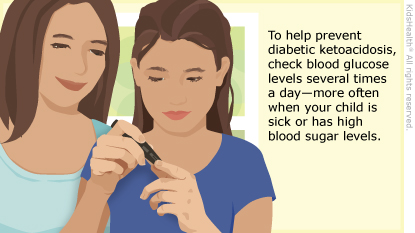Diabetic ketoacidosis (DKA) can make your child very ill. Symptoms of DKA include tiredness; increased peeing; thirst; belly pain; nausea or vomiting; fruity-smelling breath; rapid, deep breathing; severe dehydration; confusion; and unconsciousness. Diabetic ketoacidosis can be life-threatening if it's not treated right away.
In the hospital, your child received insulin, IV fluids, and electrolytes (salts and minerals) to treat and correct the chemical imbalances caused by diabetic ketoacidosis. To prevent future episodes, your child must continue with the diabetes management plan provided by the health care team.



Your child:

Your child:

How does diabetic ketoacidosis happen? Diabetic ketoacidosis happens when there isn't enough insulin in the body. Glucose (sugar) is the body's main source of energy, but we need insulin to use it. If a person with diabetes doesn't have enough insulin in the blood, the body starts to use fat for energy instead. When fat is used for fuel, chemicals called ketones enter the blood and make it acidic (having too much acid). This can cause diabetic ketoacidosis.
Several things can make a child with diabetes more likely to develop DKA, such as skipping doses or taking too little insulin; or being under stress from infection, severe injury, or emotional distress.
What are the earliest signs of diabetic ketoacidosis? The earliest signs of diabetic ketoacidosis are:
The symptoms don't always happen all at once. They usually happen over hours.